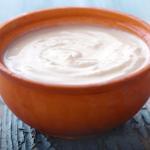The use of yogurt in cooking is not new, just as its digestive, disinfectant, antibacterial, bowel regulator and intestinal flora regenerator power is not unknown in the Middle East. Easily digestible and rich in assimilable calcium, it should be an integral part of our daily diet. In Iran it is consumed at various times of the day: at breakfast, during meals, in the form of drinks or as a side dish to dishes; many choose it as a light dinner, accompanied by vegetables or fruit in syrup. It is also the basic ingredient of sauces served with meat, eggs, vegetables and salads and is still used as a cooking liquid to cook stews and soups or in the preparation of marinades for red and white meats.
Throughout the Middle East, yogurt has been used in different quantities and ways for centuries, many of which are still unknown in the West. Its dietary and therapeutic virtues have been known for centuries, longevity and good health have always been attributed to its daily consumption. Already in the Sasanian era the first Persian recipe books contemplate it for the preparation of various dishes.
We propose below a simple yet ancient method by which it is possible to obtain a very good and very genuine home-made yogurt. Once prepared, hold a few tablespoons and use it within 3 days of production as an activator to prepare another yogurt the next time. Keep for up to a week in the fridge and if you like more compact, keep it in the fridge for a few hours before eating it. The fermentation of milk is a natural and very delicate process, the first few times so it is necessary to pay particular attention to the doses and temperature, without discouraging if you do not immediately get perfect results.
When yogurt made from cow's milk is used as a cooking liquid or as a base for dishes that require long cooking, it can easily coagulate, creating an unpleasant or at least unwanted aesthetic effect. To overcome this inconvenience and stabilize the yogurt during cooking, you can add 1 egg white beaten with a fork or 1 tablespoon of cornstarch dissolved in a little cold water to the ingredients of the recipe.
• 1 liter of fresh whole milk, possibly organic (you can also use fresh goat's or sheep's milk and cow's milk)
• 2 spoons of natural whole yoghurt, of good quality, containing live cultures (Lactobacillus bulgaricus and Streptococcus thermophilus) or two tablespoons of the one you previously produced, which you will keep in the refrigerator, hermetically sealed in a jar using a perfectly stainless steel pan clean and dry
PREPARATION
Bring the milk to a temperature of 80 ° C.
Turn off the gas and let it cool down to 40-41 ° C (touching it shouldn't burn, but neither should it give a sensation of cooled milk: the ideal is to let it cool down until you can keep it there for a few seconds by dipping a finger in it without burning yourself). Remove any film that may have formed on the surface of the milk. Now pour in the yogurt and mix long and slowly with a clean spoon; this operation will guarantee you a smooth and homogeneous yogurt. Cover the pot with a lid or a sheet of cling film and wrap it in a cloth or wool blanket, placing it away from drafts in a hot spot, around 36-37 ° C (in the oven off or under the radiator if it's winter). Now let it rest for at least 6 hours, but no more than 12. If successful, the yogurt acquires acidity and firmness over time, so from time to time check its appearance and, according to your personal taste, stop the acidification process.
If, after 12 hours, the yogurt has not formed, you will have to alas! try again, checking that all the utensils you use are clean, and that the milk is not too cold or too hot. Leaving the yogurt so prepared too long in the heat will increase its degree of acidity. With the yogurt so obtained you can prepare very tasty dishes and drinks with which you can accompany many of the dishes proposed in this book.

